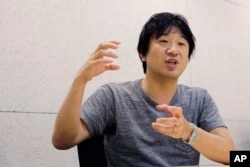This is What’s Trending Today.
Emoji have become a worldwide language for mobile phone messages. Emoji are everywhere -- displayed in New York’s Museum of Modern Art, and part of a new Hollywood film.
They all started with one man, a 25-year-old named Shigetaka Kurita. He worked for the Japanese mobile phone carrier NTT DoCoMo. In 1998, he created the first set of 176 emoji pictures.
“I happened to arrive at the idea. If I hadn’t done it, someone else would have,” Kurita said. He is now a board member at Dwango Company, a Tokyo technology company.
NTT DoCoMo’s “i-mode” mobile Internet service limited messages to 250 characters. Users, therefore, would look for shorter ways to express their thoughts.
“Digital messaging was just getting started, and so I was thinking about what was needed,” said Kurita.
After i-mode’s launch in 1999, emoji immediately became popular in Japan. In fact, Japan is where the name comes from. Emoji combines the Japanese words for “picture” and “letters.”
Kurita collected common images, including public signs, weather signs and even comic-book style images such as a light bulb or a bomb that is about to explode.
He also made five faces — happy, angry, sad, surprised and confused.
Some images easily translated across cultures. A drop of sweat rolling down a cheek clearly meant nervousness or anxiety.
Others confused some users: they mistook a video camera for a fish.
Western companies such as Apple and Google made emoji known worldwide.
Jason Snell is a technology writer. He says that many people now are most familiar with Apple’s version of emoji.
But Kurita knows that Japan is where it all began -- nearly 20 years ago.
“Japanese always are too ahead of our time,” he said.
Kurita’s creation is a big part of “The Emoji Movie,” a 2017 film by Sony Pictures about emoji that live inside the world of a smartphone. It has yet to be shown in Japan but was fairly popular in the United States.
Today, Kurita works on a popular live video streaming service called Niconico. He believes such services will become more interactive in the future, possibly with artificial intelligence.
He says he doesn’t feel very involved with emoji today. Things have changed a lot since his original designs. He receives no money from the success of emoji. He is not well known in Japan outside of the technology community.
Last year, he went to New York to see the Museum of Modern Art show. The exhibit cited him by name.
That made Kurita emotional.
“There they were, something I’d been involved with, although I’m neither an artist nor a designer,” he said. “The museum saw value in the design that had the power to change people’s lifestyles.”
And that's what's trending today.
I’m Dan Friedell.
The Associated Press reported this story. Ashley Thompson adapted it for Learning English. Kelly Jean Kelly was the editor.
__________________________________________________________________
Words in This Story
sweat - n. the clear liquid that forms on your skin when you are hot or nervous
nervousness - n. the state of being worried or afraid
interactive - adj. designed to respond to the actions, commands, etc., of a user
artificial intelligence - n. an area of computer science that deals with giving machines the ability to seem like they have human intelligence
original - adj. happening or existing first or at the beginning
exhibit - n. an object or a collection of objects that have been put out in a public space for people to look at : something shown in an exhibition








